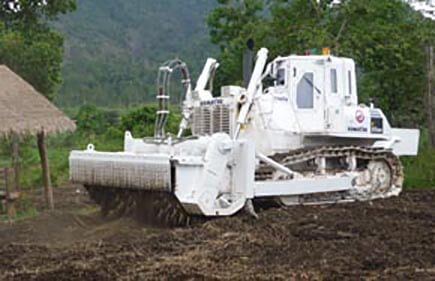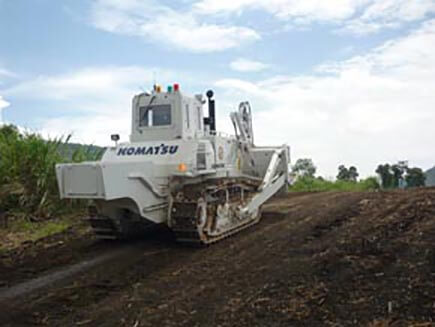2000
The IT revolution had a tremendous influence on the technology of construction equipment as well. The satellite operation management system was developed during the 90's as a method to supervise and manage equipment from a remote distance, and became an industry standard during this era.


Komatsu and a specified non-profit organization "Japan Mine Action Service" decided to work together on removal of anti-personnel land mines and the development of communities in the areas where people were suffering the damages from anti-personnel mines.
Since 1998, Komatsu had manufactured shrub removers that were used prior to removal of anti-personnel mines. In 2003, one year after the government approved export of anti-personnel mine removers, Komatsu joined the project put together by Economic Ministry of International Trade and Industry and NEDO (New Energy Development Organization) and began a full scale of development of anti-personnel mine removers.
Its prototype was finished in December 2003 and tested thoroughly in Afghanistan in 2004. In August 2007, Komatsu gave the first model to a NGO in Afghanistan with contributions from Japanese ODA (Official Development Assistance) and it was put in use in September of the same year.
The anti-personnel mine removers developed by Komatsu can handle 500㎡ an hour on average, which provides far better productivity compared to manual labor. Since its base is a bulldozer, it can fit with different attachments and be used for soil preparation and road construction once it has completed the mine removal.
There are total of 5 anti-personnel mine removers; 3 in Cambodia, 1 in Angola, and 1 in Afghanistan today. (As of November 2011)
Weight: 35,000kg
Bulldozer
Since its first emergence in 1951, it took only 50 years for the hydraulic shovel to establish its primary position on construction sites worldwide. Its size ranges from mini to super size depending on the scale of construction, and during the half century, it kept evolving by achieving a minimum rear-swing radius and adapting styles that would work with characteristics of each site. Mirroring the movement of a human hand, a hydraulic shovel will continue to evolve during the 21st century.